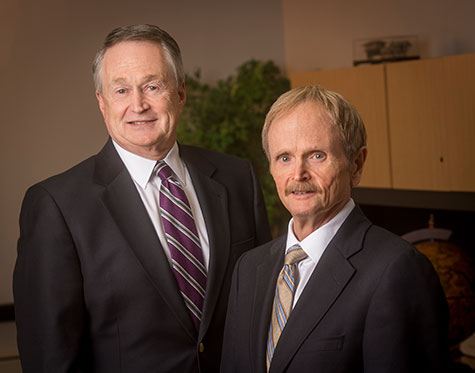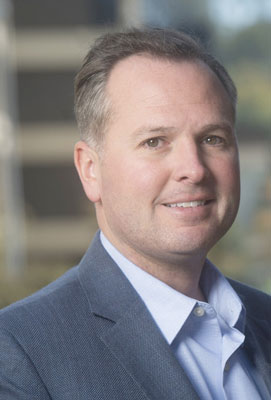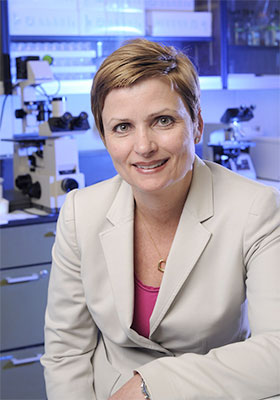 (Left) Richard Marchase, Ph.D., vice president for Research and Economic Development, and Kent Keyser, Ph.D., assistant vice president for ResearchThe University of Alabama at Birmingham is an economic engine for metro Birmingham, and research is a key driver. This impact can be measured by both the hundreds of millions of grant and contract dollars flowing to UAB and the potential to leverage the resulting discoveries and innovations into commercialization.
(Left) Richard Marchase, Ph.D., vice president for Research and Economic Development, and Kent Keyser, Ph.D., assistant vice president for ResearchThe University of Alabama at Birmingham is an economic engine for metro Birmingham, and research is a key driver. This impact can be measured by both the hundreds of millions of grant and contract dollars flowing to UAB and the potential to leverage the resulting discoveries and innovations into commercialization.To keep UAB’s research engine in tune and boost its performance, the UAB Office of the Vice President for Research and Economic Development, or OVPRED, strives toward three paramount goals, says Vice President Richard Marchase, Ph.D.:
- Facilitate the best grant applications, via a new electronic portal to Research Administration.
- Maximize research capacity
- Enhance the economic development that is based on UAB research and scholarship
UAB offices involved in IRAP include:
|
The new electronic portal to Research Administration
The major stream of UAB research dollars — including $225 million of NIH funding in fiscal 2015 — is awarded through successful grant applications. Yet the administrative burdens in proposal, protocol and report preparation are major hurdles that impede research efforts.UAB is building a single electronic entrance to its research administration offices — an interconnected group of 12 software modules called the Integrated Research Administration Portal, or IRAP. Through these, researchers can look for funding opportunities, connect with the variety of offices involved in grants and research, and have the ability to look up all records connected with a grant application. Common supporting records and documents can be shared across the modules, eliminating the need for redundant forms. Researchers can learn where a pending application is in the process. Administrators can better find and fix bottlenecks that impede workflow and lengthen turnaround times.
Effect of IRAP on processing turnaround times, 2014-15:
|
Maximizing research capacity — industry support
 Jason Nichols, O.D., MPH, Ph.D., assistant vice president for Industry Research DevelopmentMost of UAB’s research support comes from federal agencies that have strict rules and little entrepreneurial flavor. A far different revenue stream stems from contracts with industry, which offer flexibility and room for entrepreneurship.
Jason Nichols, O.D., MPH, Ph.D., assistant vice president for Industry Research DevelopmentMost of UAB’s research support comes from federal agencies that have strict rules and little entrepreneurial flavor. A far different revenue stream stems from contracts with industry, which offer flexibility and room for entrepreneurship.To better connect with that revenue stream, UAB opened an Office of Industry Engagement this fall.
“The trend in academia is to form a separate office to deal with industry, to get efficiency and speed,” said Assistant Vice President for Industry Research Development Jason Nichols, O.D., MPH, Ph.D., who came to UAB in August from the University of Houston, where he ran clinical trials and did vision science research. “We want to be industry-friendly, both internally and externally.”
Nichols’ office is examining existing practices with industry contracts: How do we do things; where are our efficiencies; where are our inefficiencies? The office also engages industry, to identify and strengthen key relationships, and to foster new relationships.
“We are a single point of contact,” Nichols said. “We can help investigators and offer advice on contracts. In a research agreement, you can negotiate for anything. They require a more entrepreneurial spirit.”
Nichols wants industry to view UAB as friendly to work with. That will begin with decreasing the time it takes to execute a Confidential Disclosure Agreement, the initial step to a possible contract. Responsibility for executing those agreements moved to Nichols’ office, and more input into the completion of the ensuing industry Research Agreements will follow.
Done well, Nichols office will lead to industry contracts that result in good science for the researchers and good data for industry. “The No. 1 goal is to build the research portfolio, and let people know we are here to support one-stop shopping,” Nichols said.
UAB contracts for industry support:
|
Maximizing research capacity — funds to support core facilities
Kent Keyser, Ph.D., assistant vice president for Research, leads two other efforts to maximize research capacity at UAB. The first involves core facilities — the centralized, shared research resources that provide access to instruments, technologies and services, and have dedicated personnel, equipment and space.Support for cores traditionally comes from fees charged to users and P-type grants from NIH. In the current tight funding environment, this support is shrinking, yet cores remain an essential part of UAB’s research capability and competitiveness.
Criteria for core support:
|
Some cores were selected for revenue shortfalls like the loss of a P grant or sharp increases in reagent and material costs. Some were selected because they need developmental funds. “Both are meritorious investments,” Keyser said.
Maximizing research capacity — new pilot interdisciplinary research centers
Keyser’s second effort to help maximize research capacity involves UAB’s university-wide interdisciplinary research centers, such as the UAB Comprehensive Cancer Center. There are 20 approved centers; but evolving strategic needs also require the launch of new, pilot centers focused on emerging areas of research.In a pilot initiative, UAB will provide funding for the Structural Biology Center, as well as three new centers pending University of Alabama System Board of Trustees approval: the Microbiome Center; the Center for Emerging Technology Investigations, Forensics and Security; and the Disability Health and Rehabilitation Science Center. Funding for each will be $100,000 a year for three years.
“These pilot centers are investments in our own investigators to stay competitive in an environment of intense competition for grants,” Keyser said.
UAB pilot centers will pair with a successful, existing center to help develop:
|
Enhancing economic development
 Kathy Nugent, Ph.D., executive director, Bill L. Harbert Institute for Innovation and EntrepreneurshipA game-changing step for UAB is the creation of the Bill L. Harbert Institute for Innovation and Entrepreneurship. The Harbert Institute is meant to support economic development at UAB and in Birmingham and the state of Alabama through campus collaborations, strategic investment, strategic development, business development, marketing and commercialization.
Kathy Nugent, Ph.D., executive director, Bill L. Harbert Institute for Innovation and EntrepreneurshipA game-changing step for UAB is the creation of the Bill L. Harbert Institute for Innovation and Entrepreneurship. The Harbert Institute is meant to support economic development at UAB and in Birmingham and the state of Alabama through campus collaborations, strategic investment, strategic development, business development, marketing and commercialization.The Harbert Institute was launched as the Institute for Innovation and Entrepreneurship in 2013, and it was renamed this year after a $5 million gift from the Joy and Bill Harbert Foundation. The funds will build space for the institute in the planned new Collat School of Business building.
| Definition of an evergreen fund: All investment proceeds flow back into the fund for its growth and maintenance |
“Our primary focus is continuing to develop ways to fully transition our campus into a place where innovation and entrepreneurship thrive,” said Kathy Nugent, Ph.D., executive director of the Harbert Institute and a senior biotechnology executive with more than 20 years of health care industry experience. “We want to continue to build strong relationships with the investigators and work harder to make Birmingham an innovation hub, anchored by UAB.”
Each year, the institute gets about 100 ideas from UAB investigators for possible patent protection and commercial development. Each Intellectual Property Disclosure goes through a triage process with a licensing team at the Harbert Institute. If a decision is made to pursue patent protection, the team also works with the investigator to develop a commercial path — with strategies and milestones for progress — for the product or technology.
Partners with the Harbert Institute for coordinated economic development will include:
|
Going forward, Nugent says the institute will:
- Train UAB investigators how to better get research out of the lab and into companies
- Develop new models to increase the number of spin-off opportunities, especially through small-business grants
- Be more aggressive in deal-making and licensing, with an emphasis on closure
- Continue to support and drive education that is related to innovation and entrepreneurship